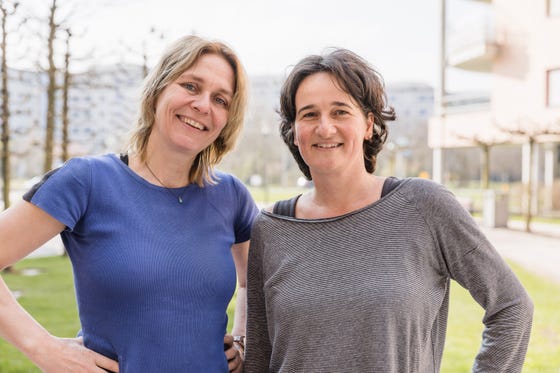Leukocyte Dynamics Group
Research line uitklapper, klik om te openen
Our major research line encompasses the quantification of leukocyte dynamics. Despite enormous advances in the field of immunology, many fundamental, quantitative insights are still lacking, including the expected lifespan of different types of leukocytes, the contribution of thymus and bone marrow output to leukocyte homeostasis, and changes in lymphocyte diversity during ageing. This lack of information hampers our understanding of the immunological changes that occur during healthy ageing, and in different diseases.
Interdisciplinary approach
Our research group aims to reveal such quantitative insights by taking an interdisciplinary approach, by combining experimental work with mathematical analyses. Experimental immunologists and mathematicians are working together on a daily basis, ensuring a permanent dialogue between the two. Using different labelling strategies, including in vivo stable isotope labelling, we study the daily production rates of different types of leukocytes, how they are maintained during healthy ageing, and how these processes are disturbed in diseases such as leukemia, HIV infection, and after haematopoietic stem-cell transplantation.
Mice and men
Our quantitative approach has pointed out that T-cell maintenance occurs fundamentally differently in laboratory mice and humans. While in mice, naive T-cell maintenance is fully dependent on thymic output, in
humans it is almost entirely due to peripheral T-cell proliferation. These differences underline the need for -and hence our focus on- in vivo studies in humans. Since research in humans naturally has its limitations, we also study leukocyte dynamics in wildling mice, a mouse model that is more natural than the typical laboratory mouse, because these mice are born to wild mice, and hence carry a natural microbiome.
Leukocyte dynamics throughout the body
Unfortunately, current insights into the human immune system are almost exclusively based on cells from the blood, a place where only a minority of immune cells reside. Most memory T-cells reside in bone marrow and non-lymphoid tissues, where they are responsible for efficient removal of previously encountered pathogens, but also cause chronic inflammatory diseases. Extremely little is known about the dynamic properties and long-term maintenance of these cells. As a result, several burning questions remain unresolved: What are the best memory T-cell subsets to transfer in cancer therapy? Should therapies against unwanted T-cell responses in the skin or gut target T-cell proliferation or migration? Which T-cell subsets should be targeted by novel vaccination strategies?
The maths of memory
We aim to fill this knowledge gap and unravel how long-term immunological memory is maintained by T lymphocytes throughout the body. We do this by quantifying the in vivo dynamics and lineage relationships of different memory T-cell subsets in the blood, bone-marrow, and lymphoid and non-lymphoid tissues of humans and wildling mice, to ensure optimal translation to future therapeutic applications. With this knowledge, we aim to lay the basis for the optimal design of immune therapies against cancer, treatment of chronic inflammatory diseases, and development of novel vaccination strategies.
Members of the Leukocyte Dynamics Group uitklapper, klik om te openen
Technicans
PhD students
- Elena de Dios-Panal
- Carina Bruckmaier
- Lyanne Derksen
- Anna Mészáros
- Shiva Joshi
- Terry Huisman
- Arpit Swain (PhD student at Theoretical Biology, Utrecht University)
- Erdem Sanal (PhD student at Theoretical Biology, Utrecht University)
Alumni PhD students
Key publications uitklapper, klik om te openen
- Baliu-Piqué M, van Hoeven V, Drylewicz J, van der Wagen LE, Janssen A, Otto SA, van Zelm MC, de Boer RJ, Kuball J, Borghans JAM, Tesselaar K (2021) Cell-density independent increased lymphocyte production and loss rates post-autologous HSCT. Elife 10:e59775. > View publication
- Den Braber I, Mugwagwa T, Vrisekoop N, Westera L, Mögling R, de Boer AB, Willems N, Schrijver EH, Spierenburg G, Gaiser K, Mul E, Otto SA, Ruiter AF, Ackermans MT, Miedema F, Borghans JA, de Boer RJ, Tesselaar K. Maintenance of peripheral naive T cells is sustained by thymus output in mice but not humans. Immunity. 2012 Feb 24;36(2):288-97. > View publication
- Westera L, van Hoeven V, Drylewicz J, Spierenburg G, van Velzen JF, de Boer RJ, Tesselaar K, Borghans JA. Lymphocyte maintenance during healthy aging requires no substantial alterations in cellular turnover. Aging Cell. 2015 Apr;14(2):219-27. > View publication
- Westera L, Drylewicz J, den Braber I, Mugwagwa T, van der Maas I, Kwast L, Volman T, van de Weg-Schrijver EH, Bartha I, Spierenburg G, Gaiser K, Ackermans MT, Asquith B, de Boer RJ, Tesselaar K, Borghans JA. Closing the gap between T-cell life span estimates from stable isotope-labeling studies in mice and humans. Blood. 2013 Sep 26;122(13):2205-12. > View publication
- Van Gent R, Schadenberg AW, Otto SA, Nievelstein RA, Sieswerda GT, Haas F, Miedema F, Tesselaar K, Jansen NJ, Borghans JA. Long-term restoration of the human T-cell compartment after thymectomy during infancy: a role for thymic regeneration? Blood. 2011 Jul 21;118(3):627-34. > View publication
Contact uitklapper, klik om te openen
Join our group
- Vacancies: There are currently no vacancies in our research group.
- Student positions: We have regular student projects, both in experimental and in mathematical immunology, and also projects in which you could combine both. If you are interested in doing an internship in our group, please contact us via e-mail.
Contact details: k.tesselaar@umcutrecht.nl, j.borghans@umcutrecht.nl
Utrecht Center for Quantitative Immunology uitklapper, klik om te openen
We are part of the Utrecht Center for Quantitative Immunology (UCQI), which aims for a more quantitative approach of immunology. UCQI brings together a collaborative team of immunologists, bioinformaticians and mathematicians with a shared interest in quantitative immunology

